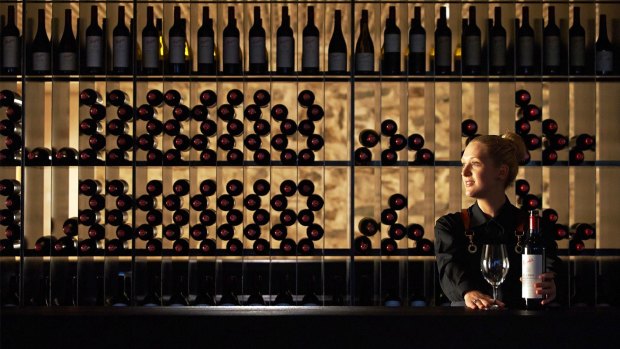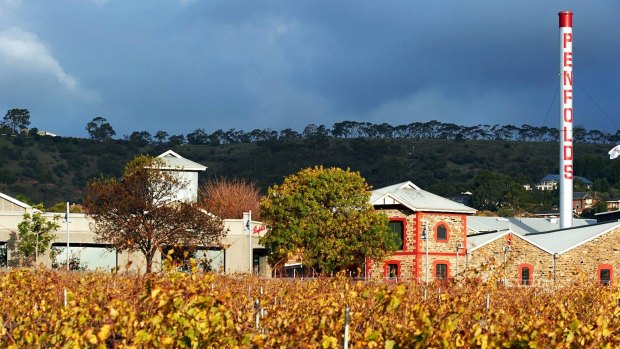This was published 8 years ago
Penfolds Magill Estate, South Australia: Penfolds revolution fermented in Magill
By Mark Eggleton

Penfolds Magill Estate cellar door tasting bar.Credit:
SPONSORED ARTICLE
There's something positively Willy Wonka about Penfolds Magill Estate.
It's the near-magical drive up the entrance road, past the estate's old Shiraz vines, and the looming bluestone buildings melding old and new sitting at the end of the road.

Penfolds Magill Estate.Credit:
A silvery grey, metal chimney with Penfolds written in red down its side rises 20m into the air from the centre of the winery.
There is a chocolate box whimsy about the whole estate. If you're lucky enough to wend your way through the old offices and their dark coffee timber interiors you know something rich and fulfilling is created here.
Venture down into the drives (tunnels) on a cellar door tour and while you might be pointed towards the Helen Keller Vat or some of the older tunnels used to cellar Grange, your eyes wander looking for the river of wine or maybe an Oompa-Loompa or two.
For wine lovers it's a grown-up Disneyland.
Memo to Penfolds: All it needs is a ride or two. Maybe a Space Mountain like experience where you're thrown around inside a massive glass of opaque red-brick coloured liquid or maybe not.
Generational pilgrimage
Penfolds chief winemaker Peter Gago says Australians seem to have a connection with the place.
"You see grandparents bringing their grandchildren to visit. Not for the wine but the buildings, the ambience. It's part of so many people's wine journey because they grew up tasting Penfolds.
Gago agrees there is a certain theatre about Magill from the moment you drive through the gates.
"You drive through the gate and you're surrounded by a vineyard as you drive up the roadway. Walk in and you can see the winemaking process. The cellar door overlooks the city and the Gulf of St Vincent. In the late afternoon, the sun sets as a magnificent red orb on the gulf. It's quite magical."
"This place is not a showcase or replica - it's a living breathing thing. People can come during harvest and they can smell the ferments, see it bubbling and see the grapes coming in. It's real and goes for about 10 weeks."
Wander along the winery's narrow laneways and you're transported back to a small 19th century village. Its inhabitants quiet while they wait to bring in the yearly harvest. Outside harvest time, the estate gently hums along. The only sounds come from the occasional tour or the cellar door where visitors taste wine or enjoy the creations of Scott Huggins and Emma McCaskill in the Magill Estate Kitchen.
During harvest the smells and aromatics waft through the winery, through every building and spilling out down the drive. The grapes come in from the vineyard below, they lie in open fermenters in the fermentation cellar, they're basket pressed and then it's less than 10m to barrel.
"It's always changing, it ticks and all always marches on. No two days are ever the same," Gago says.
"Come outside harvest and you can look at the vineyard. In winter the vines are dormant then there's bud burst, leaf, then grapes and then it all happens again.
"It's a true wine experience just a stone's throw away from the city."
Beating heart of nation's wine culture
Gago says while Magill Estate is quintessentially a South Australian experience, it's an Australian story overall. To really experience South Australia he suggests a little time is needed.
A transplanted Melbournian, he's passionate about his adopted home because it just offers everything you need - theatre, wine, food and culture.
"There's something about Adelaide and it's also not far to the foothills of the Adelaide Hills, to the Barossa or south to McLaren Vale in the Fleurieu Peninsula.
"Heading south-east down into the Limestone Coast region you hit that road and while your mind might be at work, everything relaxes."
A drive up into the Adelaide Hills and its patchwork quilt of vineyards and gullies is one of Gago's guilty pleasures where he still deliberately gets lost on a meandering drive.
"So much of South Australia is not immediately in your face, you have to seek it out."
As for Adelaide, Gago's favourite activities often involve action such as climbing up to Mount Lofty or the waterfall walks in the area and staring out to the sea.
"There are great pop-up restaurants and food vans in the city. Then there is the new Adelaide Oval precinct and some great new restaurants. It's a wonderful mix of the new and old world."
Back at Magill Estate, visitors can visit the shiny new cellar door and try a few glasses of the latest release wines or even do specific tastings of back vintages or Grange tours.
Taste forbidden fruit
Hidden away in one of the new cellar door's tasting rooms is the cupboard where the father of Grange Max Schubert used to squirrel away his test vintages of Australia's most famous wine. At the time an overzealous management had forbidden Schubert from making the style.
"Come here at harvest and you can have a taste of a ferment perhaps. Some people taste a ferment and come back three years later on the wine's release."
Apart from the winery and its 19th century history, the estate boasts two of Adelaide's best dining experiences. Magill Estate restaurant sits in a cutting edge building, which complements its surrounds where chefs Emma McCaskill and Scott Huggins turn out extraordinary food. Alternatively, the kitchen is a very relaxed space where diners can have something more casual while enjoying a glass of wine.
"The restaurant – it's very modern and your first experience is that modern décor. As the sun sets and the shutters open in the early evening, you look over the vineyard and across to the lights of Adelaide. Then it's the food and wine while Adelaide's nighttime beauty unfolds in front of you."
On offer is a degustation menu where diners can buy every Grange back to 1951 including the 1971 which recently came out on top in the European luxury magazine Fine as world's greatest wine of the 70s.
They can also try a glass or two of Bin 60a from 1962, which is acknowledged in many quarters as Australia's greatest ever wine.
"It's incredible food and there is so much depth to the wine list."
Obviously it's the wine and winemaking process which drives the fire within Gago and he's continuously excited about some of the wines made at Magill.
He talks passionately about the Penfold family history at Magill, it being the birthplace of Grange and the style's creator Max Schubert. Moreover, he's genuinely honoured to be part of the Penfolds tradition and how the links to its past are lovingly celebrated.
"It's part of Australian winemaking history. Here at Magill we are fermenting wines where the first Grange was fermented. Now we are creating our own history with the new varieties. We are always progressing, always looking forward.
"Winemaking is a bit of an art, a bit of science, alchemy and a bit of luck thrown in."
As for Magill Estate, Gago says people always come back.
"There are connections here and hooks here. It's a special place – an oasis."
This article brought to you in association with the South Australian Tourism Commission.
Sign up for the Traveller Deals newsletter
Get exclusive travel deals delivered straight to your inbox. Sign up now.